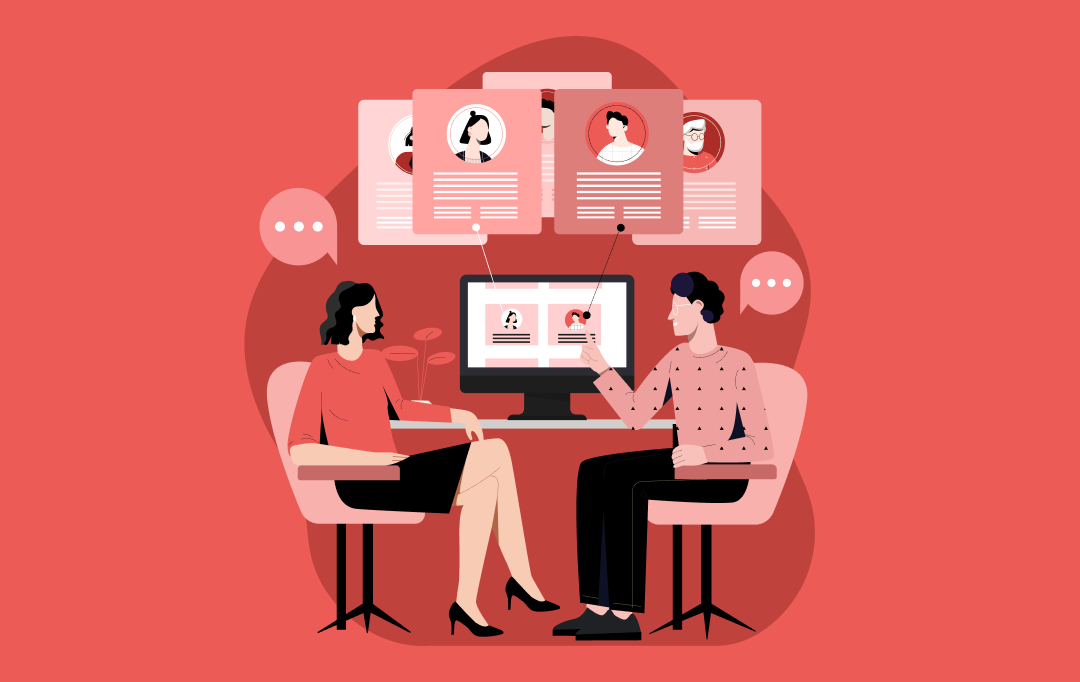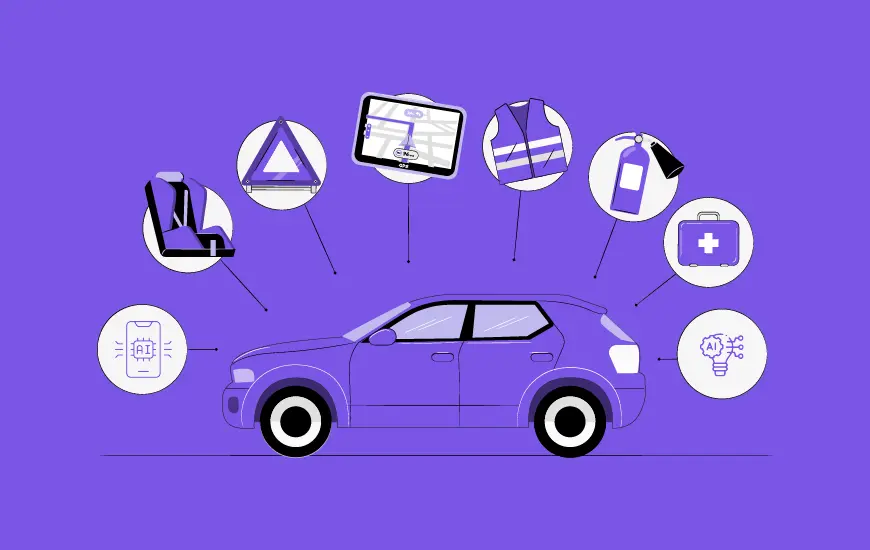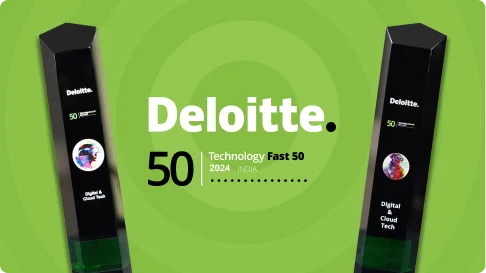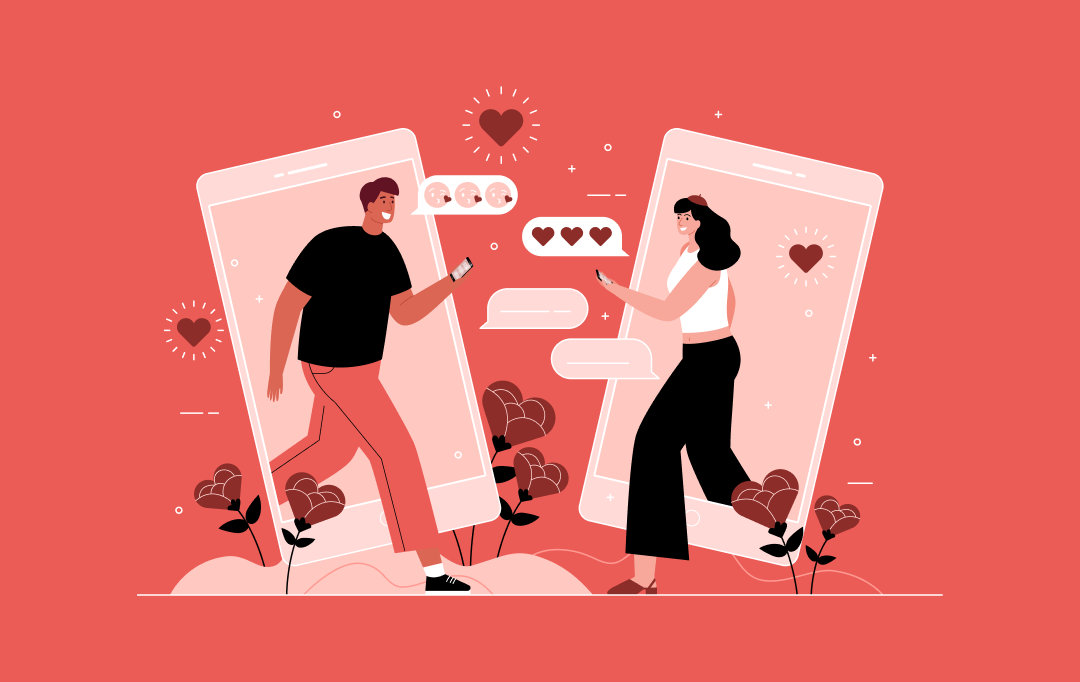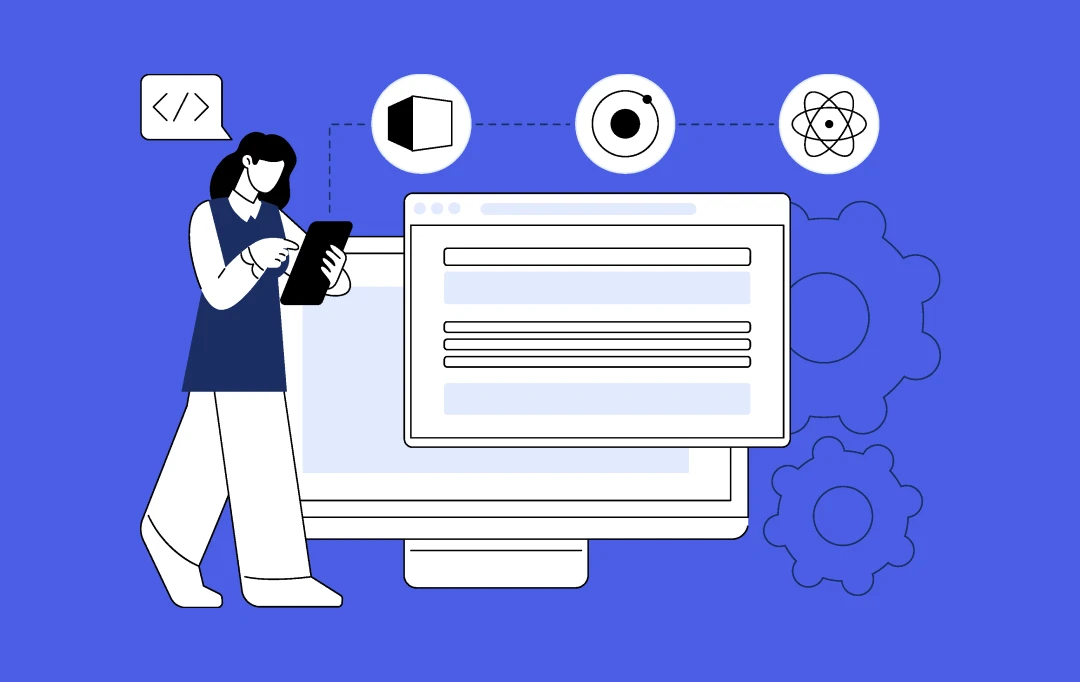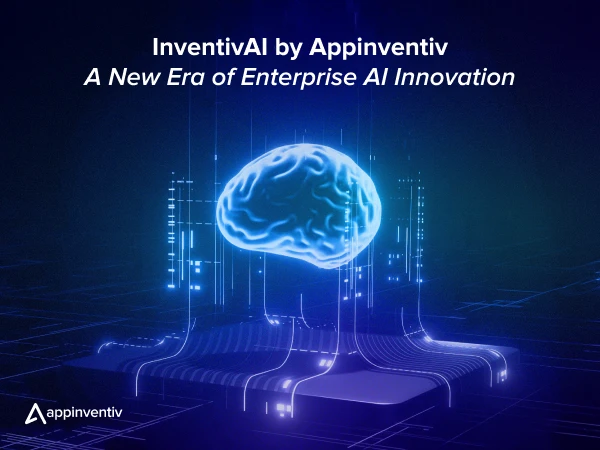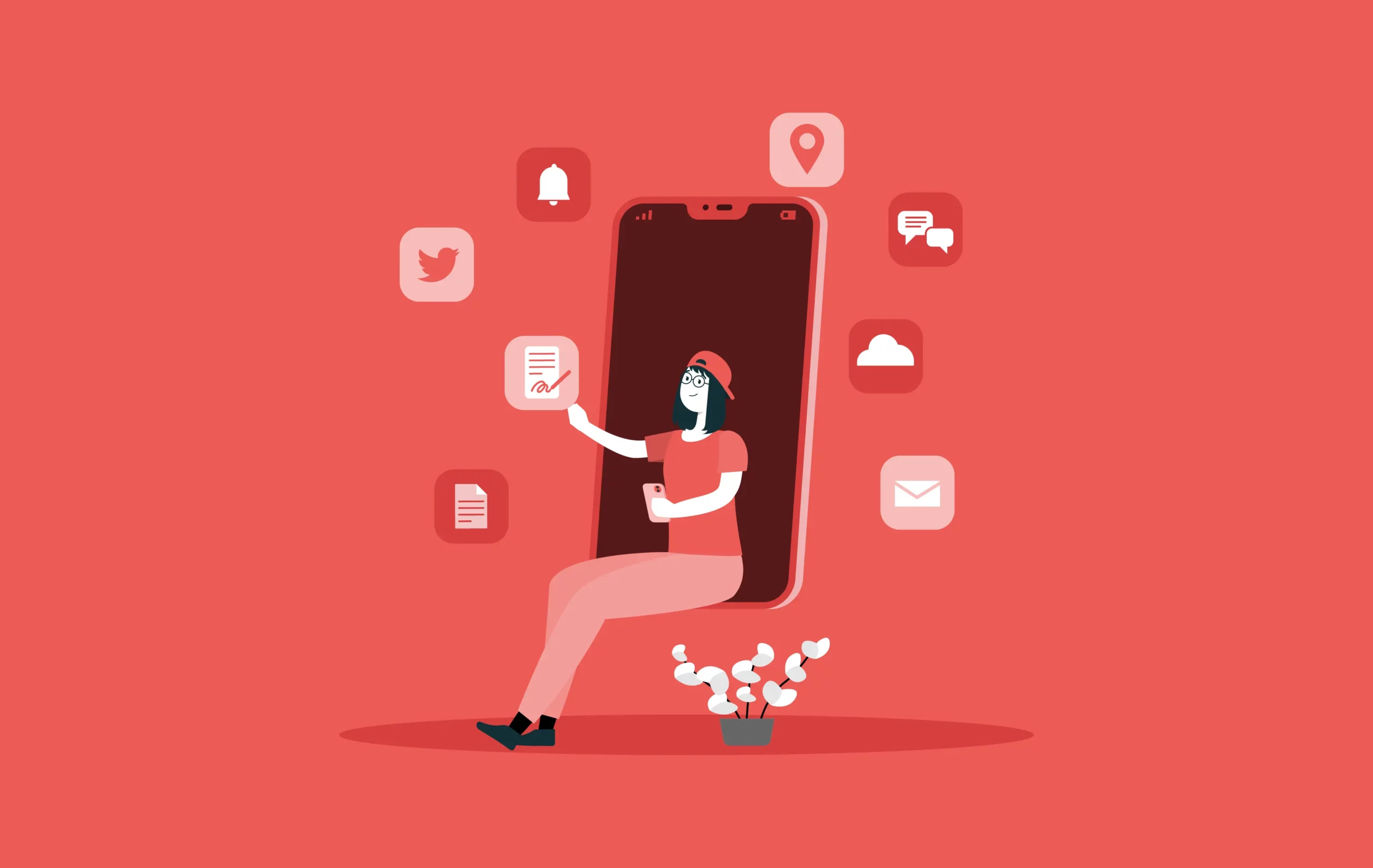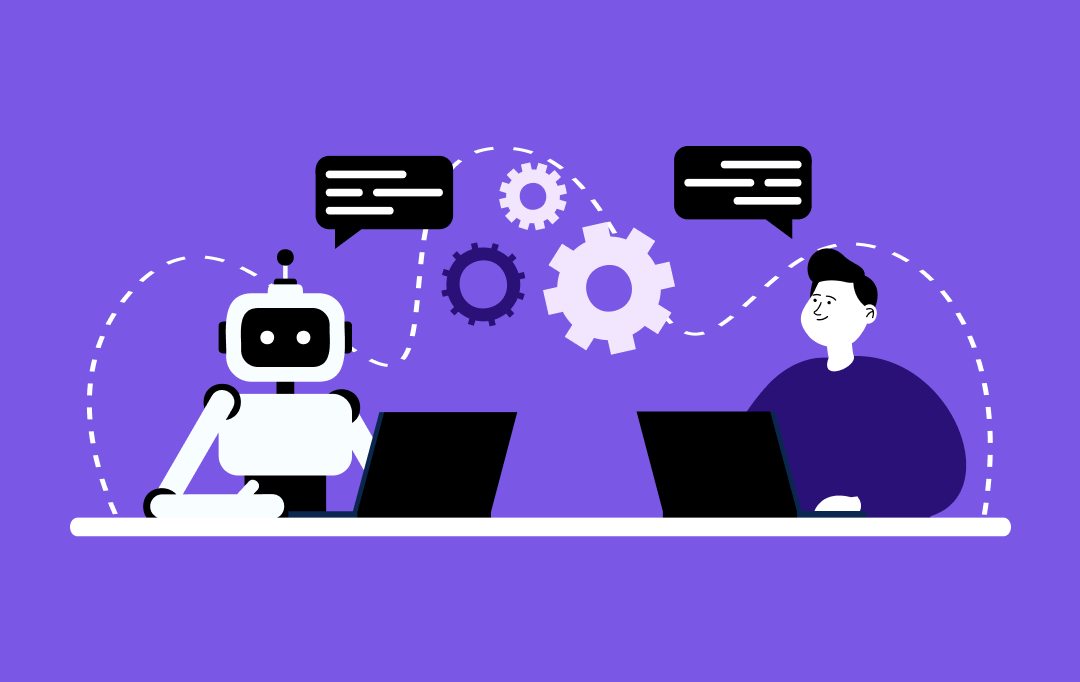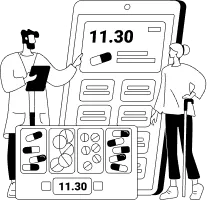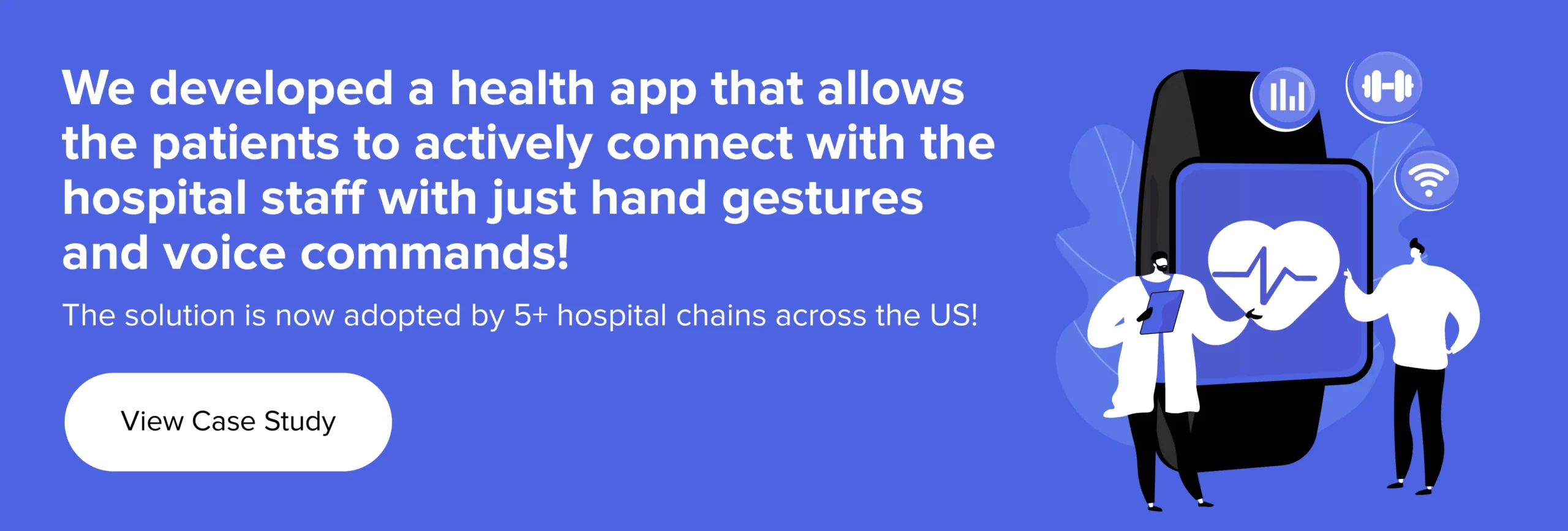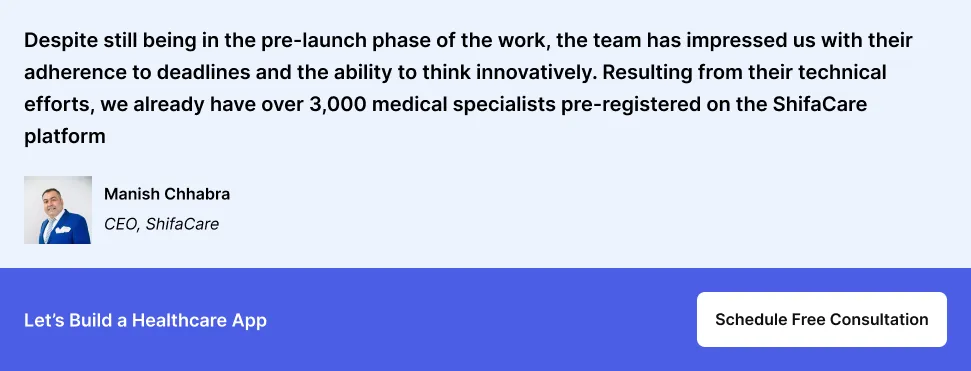- Where Does IoT Fit in Healthcare?
- Key Segments of IoMT
- How IoMT Benefits Stakeholders
- How Does the Internet of Healthcare Things (IoHT) Work?
- What Are the Benefits of IoT in Healthcare?
- Simultaneous Reporting and Monitoring
- End-to-End Connectivity and Affordability
- Data Analysis and Data Assortment
- Assisting the Elderly
- Real-Time Tracking and Alerts
- Check-Up on the Go
- Use Cases of IoT in Healthcare
- Remote Patient Monitoring
- Reduced Waiting Time
- Hardware Maintenance Tracking
- Employees and Patients Tracking
- Drug Management
- Identification of Chronic Diseases
- Examples of the IoT Medical Devices
- Hearables
- Moodables
- Smart Thermometers
- Smart Pills
- Insulin Pens
- Healthcare Charting
- Challenges Faced in IoT-based Healthcare Systems and Strategies to Overcome Them
- Privacy and Security
- Multiple Devices and Protocol Integration
- Overloading and Inaccuracy
- The Future of IoT for Healthcare
- How Can Appinventiv Pave the Way for Your Medical IoT Success?
- FAQs
- Q. How is IoT being used in healthcare?
- Q. How will the Internet of Things (IoT) affect healthcare?
- Q. What is the importance of IoT in healthcare?
- Q. What are the benefits of an Internet of Things-enabled (IoT-enabled) medical device?
- Q. What is the role of AI and IoT in healthcare?
- Q. What are the advantages and disadvantages of IoT in healthcare?
In 2024, an incident unfolded that completely changed how we perceive healthcare technology.
| An older woman’s Apple Watch detected an irregular heartbeat—a potential sign of atrial fibrillation (AFib)—and immediately alerted her to seek medical attention. This single, life-saving alert averted a possible crisis and demonstrated the revolutionary power of IoT-connected wearable devices in early detection and preventive care. |
With the emerging integration of the Internet of Things in healthcare market, we no longer rely solely on periodic check-ups and reactive treatments. Smart IoT devices continuously monitor vital health metrics like sleep quality, insulin level, heart rate, etc., and provide real-time insights that empower us to take control of our health and prompt proactive action before emergencies arise.
According to Statista, the global Internet of Things in the healthcare market is expected to reach a revenue of $93.28 billion by 2025, leading to a market volume of $134.40 billion by 2029. This IoT in healthcare market growth is driven by the rising demand for remote patient monitoring, advancements in wearable technology, and the growing need for efficient healthcare management systems.
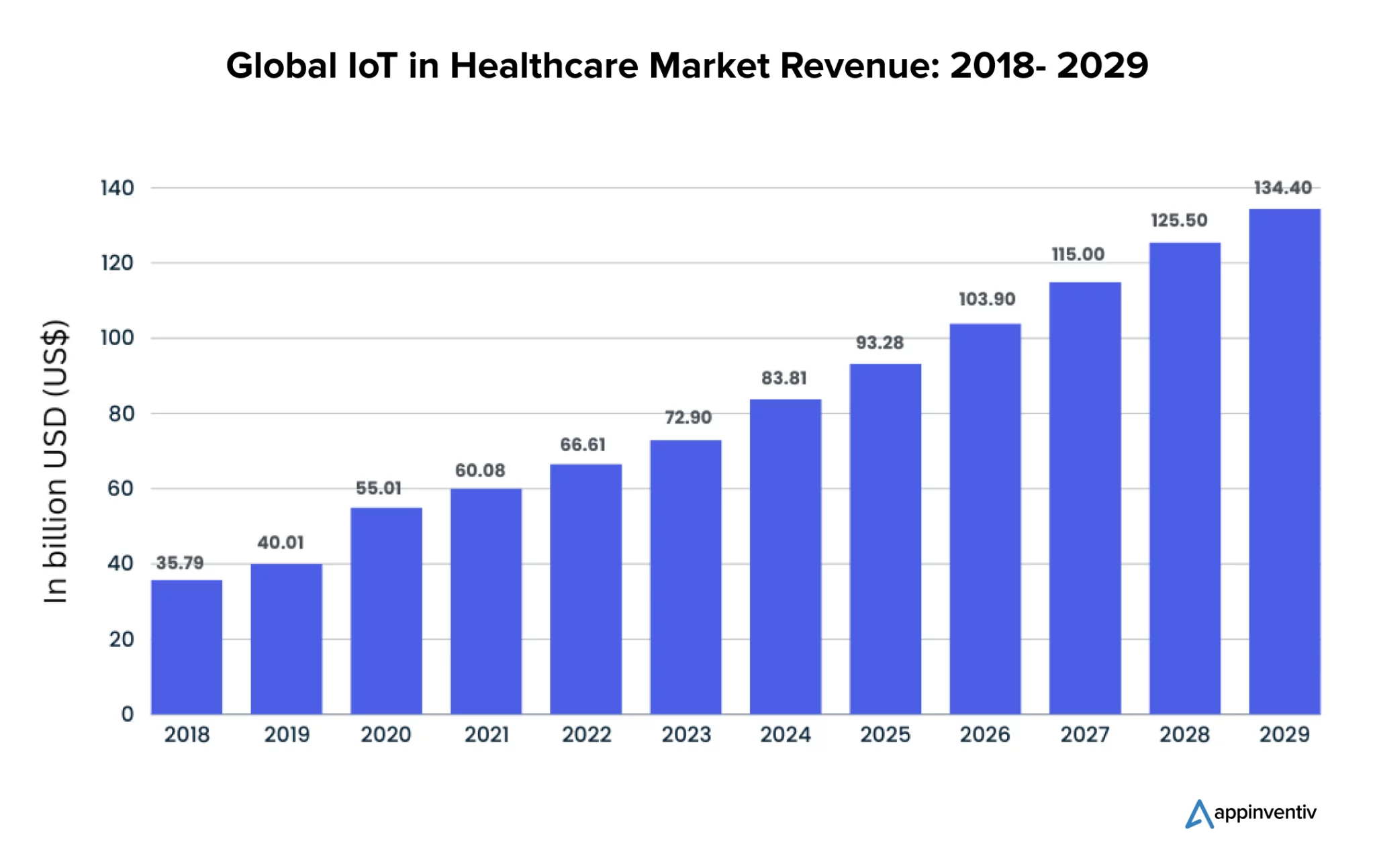
The influence of IoT on healthcare has grown rapidly. This cutting-edge technology has the potential to save lives with the help of rapid disease diagnosis and the identification of suitable treatment options for patients.
Beyond these basics, IoT in healthcare is revolutionizing the industry and significantly addresses the challenge of limited accessibility and delayed patient care. The technology empowers healthcare professionals to monitor patients remotely, greatly improving accessibility and bridging care gaps.
In this blog post, we will explore how IoT is changing healthcare and discuss its transformative benefits, use cases, examples, and challenges in implementing the technology in the industry. So, without further ado, let’s get started.
Built a cutting-edge IoT solution tailored to your need to leverage such benefits.
Where Does IoT Fit in Healthcare?
As IoT technology evolves, its healthcare application – the Internet of Medical Things (IoMT) – transforms patient care by connecting doctors and patients virtually.
IoMT is a network of smart, connected devices that collect and share real-time data, enabling more accurate monitoring and timely interventions. It is one of the key applications of IoT for healthcare, positively impacting the industry, and can potentially solve medical issues.
This innovative technology goes beyond early disease detection; it prevents potential health issues and manages existing conditions. With wearables and smart sensors integrated into daily life, patient health can be continuously tracked without constant in-person visits.
Moreover, IoMT is tailored to address specific challenges within the healthcare industry, with dedicated solutions for various medical issues. As a result, IoMT is not only streamlining how care is delivered but also paving the way for more proactive and personalized treatment strategies.

Key Segments of IoMT
The Internet of Medical Things has divided segments for each medical issue faced by the healthcare industry:
On-body Segment – This focuses on customer health wearables and other medical-grade devices designed to monitor various health metrics. Some popular products used in this segment are Fitbit, Apple Watch, and Amazfit Smartwatches.
In-Home Segment – This aims to provide individuals with personal health tracker solutions for everyday use. This segment includes personal emergency response systems (PERS), telehealth virtual visits, and remote patient monitoring (RPM), all designed to help individuals manage their health comfortably at home.
Community Segment – This segment is built around five core components: Kiosks that dispense products and provide services, mobility solutions that bring care to patients’ vehicles, emergency response intelligence for faster medical interventions, point-of-care devices that act like medical camps, and logistics systems that keep a record of all the medical equipment and goods.
In-Clinic Segment – This segment includes IoMT devices that can be used inside a clinic to provide healthcare services. The medical IoT solutions of the in-clinic segment also provide point-of-care devices that support rapid diagnostics and treatment, ensuring that care within the clinic is both efficient and effective.
In-Hospital Segment – This category covers a wide range of IoT applications aimed at streamlining hospital operations. It includes systems for asset management monitors, personnel management, patient flow management, inventory management, and environment and energy monitoring.
How IoMT Benefits Stakeholders
When we look at the applications of IoT in healthcare across different levels, we can witness that the technology is making an industry-wide impact on patients, physicians, and hospitals. To know more, let’s read further:
For Patients
Wearable smart devices in healthcare, like glucometers, heart rate cuffs, fitness bands, etc., give patients access to personalized attention. These devices’ constant tracking ability can majorly impact people who live alone as they can send alerts to their family members or healthcare.
For Physicians
Physicians can track patients ‘ health more effectively through medical IoT wearables and home monitoring devices embedded with IoT technology. The data gathered from the Internet of Things healthcare devices can help doctors identify the best patient treatment plan and monitoring process. This brings together the Internet of Things and healthcare to witness better results.
For Hospitals
In hospitals, IoT is embedded with sensors to track the real-time location of medical enablers and equipment such as defibrillators, wheelchairs, oxygen pumps, nebulizers, and other similar monitoring devices. Additionally, IoMT assists in staff deployment, pharmacy inventory control, and environmental monitoring.
IoT for Health Insurance Companies
Healthcare IoT platforms offer significant advantages to health insurance companies by providing accurate, real-time health data. The insurance firms leverage this information to assess patient risk profiles, streamline the claims process, and tailor insurance plans to individual health metrics. By adopting a data-driven approach, insurers can improve service efficiency and customer satisfaction through proactive and preventive care strategies. Additionally, IoT data aids in detecting potential fraud by comparing reported claims with actual health records.
Addressing Healthcare Challenges with IoMT
Through its multi-stakeholder involvement, medical IoT solves several pain points that are prevalent in a healthcare ecosystem, such as:
- Inefficient patient care
- Medical errors and misdiagnoses
- Supply chain management
- Gaps in medical research
- Limited healthcare access in rural areas
- Inefficiency in insurance claims and settlement
As IoMT adoption continues to grow, it is redefining the future of connected healthcare, driving better patient outcomes, modernizing hospital operations, streamlining insurance claim processes, and improving healthcare accessibility.
How Does the Internet of Healthcare Things (IoHT) Work?
IoT products typically function through a four-stage process carried out pragmatically by medical IoT companies. Each stage is further tightly integrated in terms of data capture and processing.
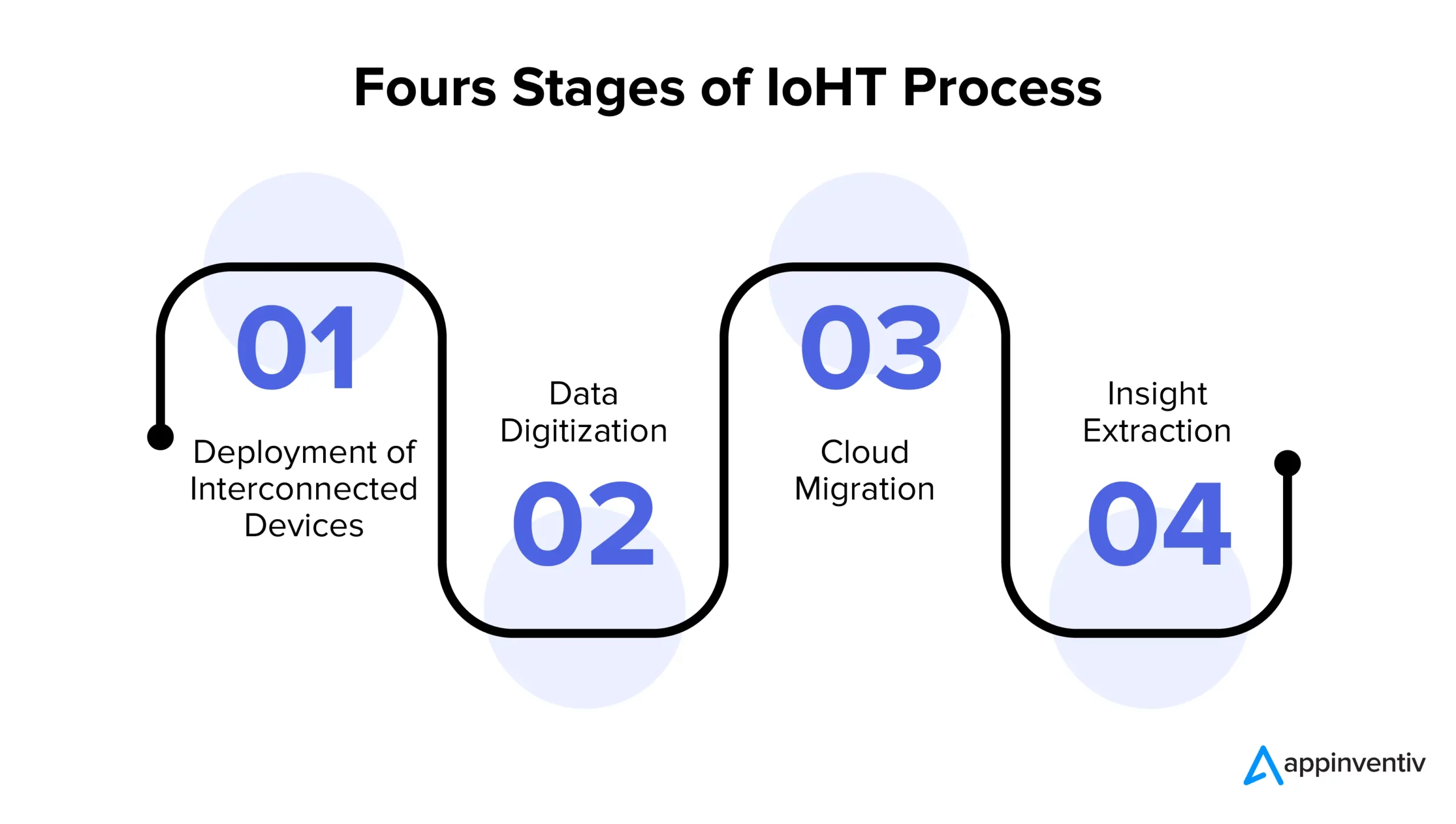
Stage 1: Deployment of Interconnected Devices – This involves sensors, actuators, monitors, detectors, and camera systems that collect data.
Stage 2: Data Digitization – The analog data received from sensors and other devices is then aggregated and converted into a digital form.
Stage 3: Cloud Migration – The data is transferred to a cloud data center after the pre-processing and standardization.
Stage 4: Insight Extraction – Doctors or health practitioners can take actionable insights and make informed decisions based on the processed data.
Also Read: Machine Learning in Healthcare: Applications, Benefits, and the Future of Medical Innovation
What Are the Benefits of IoT in Healthcare?
The integration of IoT in healthcare is revolutionizing patient care and hospital management. As the healthcare sector faces increasing pressure due to rapid population growth, aging demographics, and the growing prevalence of chronic illnesses, IoT-driven solutions are proving to be a game-changer. IoT bridges healthcare delivery gaps by enabling real-time monitoring, data-driven decision-making, improved operational efficiency, and more. Here are some of the most significant benefits of IoT in healthcare.

Simultaneous Reporting and Monitoring
IoT solutions in healthcare enable doctors to monitor the real-time conditions of a patient, which can prevent any emergencies like heart failure, diabetes, asthma attack, cardiac arrest, etc.
For example, a patient’s vital signs can be monitored in real-time with the help of IoMT devices, and the data can be reported immediately to their doctor. This is especially beneficial in emergencies where every second counts.
Another example is in clinical trials where data from multiple patients can be collected and analyzed simultaneously. This helps to speed up the process of finding new treatments and cures for diseases.
End-to-End Connectivity and Affordability
IoT healthcare allows better connectivity and data sharing. Medical devices can seamlessly communicate with IoT connectivity technologies like Bluetooth, Wi-Fi, and cloud integration, making disease diagnosis and monitoring faster and more precise.
For example, IoT can connect different devices and systems within a hospital to improve care coordination. In addition, IoT healthcare companies can leverage the technology to reduce care costs by increasing efficiencies and improving patient outcomes.
IoT can also help remotely monitor patients with chronic conditions, reducing hospital readmissions. Similarly, smart pills and wearable sensors can help improve medication adherence and prevent adverse events.
Data Analysis and Data Assortment
The benefits of IoT connectivity in healthcare involve storing massive amounts of patient medical history data. IoT devices transmit this data to other devices, and while analyzing such extensive datasets manually may seem unthinkable, IoMT devices do this task in minutes.
By leveraging cloud-based infrastructure, Internet of Things medical devices can gather, analyze, track, send, and receive data with the help of a cloud base. Since traditional servers cannot store such massive datasets, cloud integration is required to ensure secure and scalable data management.
Assisting the Elderly
One major area that is particularly benefiting from the implementation of IoT healthcare solutions is the assistance of the elderly. By equipping seniors with IoT medical devices that can track their vital signs and provide reminders for taking medications, caregivers can provide a higher level of care while reducing the risk of hospitalization or other health complications.
Moreover, IoT-enabled devices can also monitor falls and notify caregivers immediately in any emergency. Many renowned brands like Philips Lifeline, Apple, etc., have integrated a fall detection system into their devices that detects if the user falls.
For example, A woman from Gainesville, Florida, collapsed in her hotel room due to a ruptured aorta. Her Apple Watch detected the fall and immediately dialed 911, ensuring she received immediate medical attention.
As the population ages and the need for quality healthcare increases, IoT solutions have become increasingly important in ensuring seniors receive the care they need.
Real-Time Tracking and Alerts
Imagine how many lives can be saved with emergency alerts triggered by distressed patients. The Internet of Medical Things has made this possible. With the help of smart devices in healthcare, a patient’s medical information is recorded in real time and can be sent to the doctor. If there is any abnormality, the doctor will be informed immediately and can assist accordingly.
For example, a patient with a heart condition wears a wearable device that monitors his/her heart rate continuously. If the device detects an abnormal heart rate, it could alert the patient’s doctor in real-time. This would allow the doctor to take action immediately, potentially preventing a serious health complication.
Check-Up on the Go
With the help of IoT healthcare devices, patients can easily contact doctors on their mobile devices and get immediate assistance. With the latest IoT medical devices, doctors can identify any ailments on the go while saving travel costs and time.
For example, sensor-equipped medical devices can transmit patient data to a central location where doctors and nurses can monitor it. This allows for a more timely and accurate diagnosis of problems and the ability to provide personalized care. In addition, IoT in healthcare can reduce the cost of care by minimizing the need for office visits and hospitalizations.
Also Read: The Intersection of IoT and Robotics: Transforming Industries and Workforce
Use Cases of IoT in Healthcare
IoT healthcare solutions are revolutionizing the industry by enhancing patient monitoring, enabling virtual assistance, and streamlining medical processes. From real-time health tracking to remote consultations, its applications are vast and transformative. Here are some key use cases of IoT in healthcare.
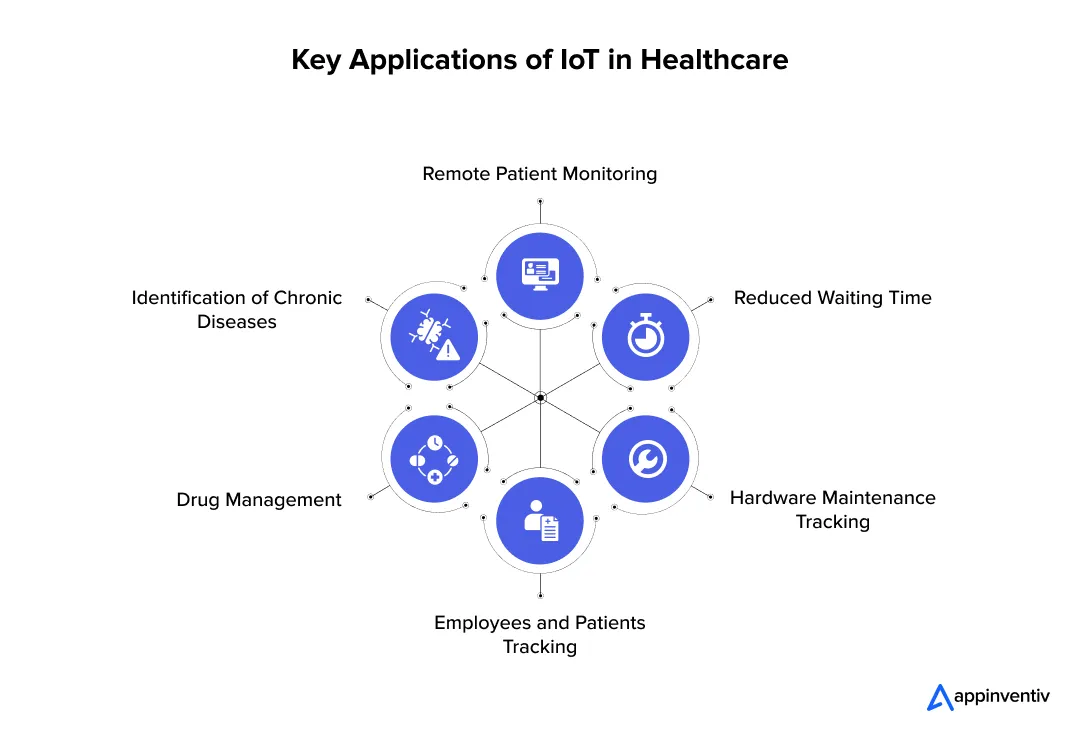
Remote Patient Monitoring
The most common IoT healthcare use case is remote patient monitoring. The medical IoT devices are built to collect vital health metrics like blood pressure, heart rate, temperature, etc., from patients who are not physically present in the healthcare facility. Advanced algorithms analyze this data, recommend treatments, and trigger alerts in case of anomalies.
According to Grand View Research, the global remote patient monitoring system market is expected to reach $16.9 billion in 2030, witnessing a CAGR of 18.6% from 2024 to 2030. The increasing market size can be attributed to the rising demand for RPM systems due to their ability to offer improved chronic disease management and timely assistance.
Reduced Waiting Time
Patient satisfaction is a key metric in healthcare, and reducing waiting time is one way to improve patient satisfaction scores. IoT healthcare services can play a role in reducing waiting time in several ways.
For example, IoT-enabled patient check-in can help speed up the registration process. Also, IoT-connected devices can be used to track the location of patients and staff in real-time, which can help optimize patient flow through the facility. By reducing waiting times, IoT can help improve the patient experience and satisfaction scores.
Hardware Maintenance Tracking
One of IoMT’s most important use cases in the healthcare industry is keeping track of hardware maintenance. Imagine a hospital with hundreds of pieces of medical equipment. It would be nearly impossible for the staff to track when each piece of equipment was last serviced.
However, with a medical IoT system, each piece of equipment could have a sensor that would send data to a central database. This system ensures timely servicing, reduces breakdown risks, and improves operational efficiency, ultimately contributing to better patient care. In a hospital setting, even a short downtime can have serious consequences, so an IoMT system like this could save lives.
Employees and Patients Tracking
The hospitals have huge buildings, so tracking where every employee or doctor is at a particular moment becomes impossible. It is the same for all the patients as well. With healthcare Internet of Things, tracking the patients and the staff is easy.
This technology also tracks the hospital’s assets for security reasons. It is a highly efficient technology that tracks objects or people without additional cost or effort.
You may like reading: How is artificial intelligence making the healthcare sector intelligent?
Drug Management
With IoT-enabled devices, patients can receive real-time alerts when it is time to take their medication. The data collected by these devices can also be used to track medication adherence and identify potential drug therapy issues.
Moreover, IoT can monitor the storage and transport of medications, ensuring that they are kept at the correct temperature and protected from tampering. By making drug management more efficient and effective, IoT in healthcare can improve patient outcomes and reduce healthcare costs.
Identification of Chronic Diseases
The Internet of Things healthcare technology identifies a patient’s chronic illness. The patient enters his symptoms, and the IoT healthcare devices compare it with existing medical data to identify the disease.
Wearable devices like Fitbit track heart rate, sugar, and blood pressure levels. Custom Healthcare app development for wearables and mobile apps has made individuals more health-conscious and proactive about managing their medical conditions.
For instance, DiabeticU, a diabetes management app developed by Appinventiv, integrates seamlessly with wearable devices to help users monitor their blood sugar levels in real-time. The app provides personalized meal plans, medication tracking, exercise schedules, and lifestyle recommendations, enabling better diabetes control and improved health outcomes.

Also Read: How is NB-IoT Transforming Industries? 10 Use Cases and Benefits
Examples of the IoT Medical Devices
The integration of IoT in healthcare has led to the development of advanced medical devices that enhance patient monitoring, critical disease diagnosis, and personalized treatment. These smart healthcare IoT devices collect and transmit real-time health data, enabling faster decision-making and transforming healthcare delivery. Here are some key examples of healthcare IoT devices that significantly impact the industry.
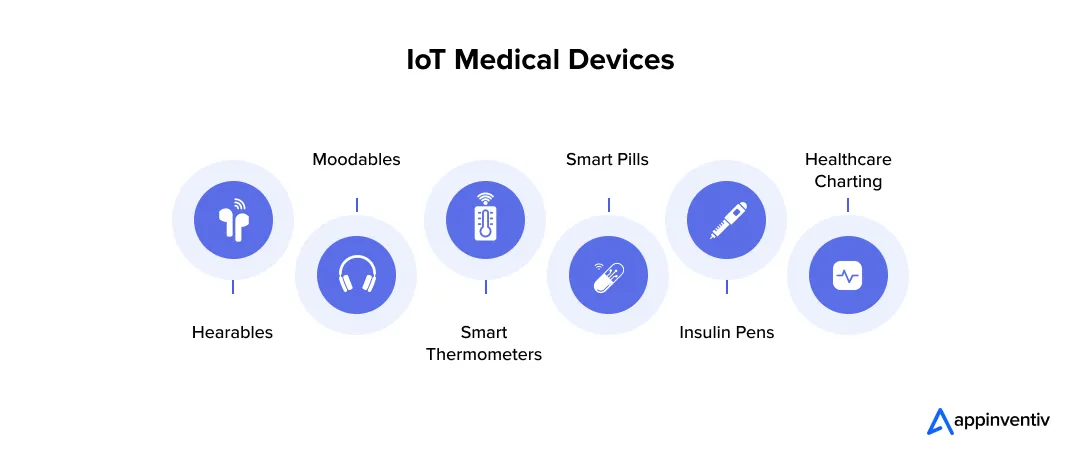
Hearables
Hearing aids have been around for ages, but these devices have undergone a massive transformation with time. Modern hearables now sync with smartphones via Bluetooth, allowing users to filter, equalize, and customize sounds for a more natural listening experience. These innovations have significantly improved how individuals with hearing loss interact with their surroundings.
Moodables
Stress can often deteriorate mental health, and there are times when patients with mental disorders or neurovascular problems need to uplift their moods. Various moodable devices developed by companies like Melon, Muse, and Emotiv claim to improve post-traumatic stress disorder and help patients relax. These devices are mounted on the head, passing low-intensity currents to the brain. These electrical impulses help alleviate the stress and lighten up the mood/mind.
Smart Thermometers
Smart thermometers are used to continuously monitor a patient’s temperature, providing real-time data that can be used to detect early signs of illness. These smart thermometers can also be connected to IoT devices like blood pressure and heart rate monitors. This allows for a more comprehensive view of a patient’s health, making it possible to identify potential problems sooner.
Smart Pills
Smart pills are edible healthcare IoT pills that monitor our body functioning and alert us if any anomaly arises. For instance, scientists at the California Institute of Technology have built a mini medical chip that can be used as a smart pill.
These tiny pills can be swallowed and then travel through the digestive system, transmitting data and images about the body’s condition to an external receiver. This has many potential applications, from monitoring gastrointestinal bleeding to detecting early signs of cancer. Additionally, ingestible sensors can help track medication adherence by sending alerts when a patient misses a dose, ensuring timely and effective treatment.
One can easily access the data through their smartphones. This is one of the most important benefits of IoT in healthcare, which proves how powerful the technology is.
Insulin Pens
The potential benefits of insulin pens are numerous, positively impacting the lives of patients with diabetes. Insulin delivery devices are connected to the Internet and can be controlled remotely. This means that patients with diabetes can manage their condition more effectively and with less hassle.
In addition, insulin pens can provide real-time data to doctors and other healthcare professionals, allowing for more accurate monitoring and treatment of diabetes.
Bonus Read- How much does it cost to build a diabetes management app like MySugr
Healthcare Charting
Patient charting is a time-intensive task for doctors, requiring meticulous documentation of demographics, diagnosis, medications, treatment plans, progress notes, immunization plans and schemes, allergies, tests (X-ray, cardiology, radiology, urine, blood, etc.), and the results. With IoT integration, clinicians can now access and update patient records using voice commands, streamlining the process and reducing administrative burden. For instance, platforms like Augmedix help in medical documentation so clinicians can focus on patient care.
Also Read: The future of clinical trials – Unlocking AI’s potential to revolutionize healthcare research
Challenges Faced in IoT-based Healthcare Systems and Strategies to Overcome Them
Even though IoT solutions in healthcare are transforming the industry at a rapid pace, their adoption in the industry is not without challenges. IoT implementation in healthcare comes with several limitations and considerations. Let us look at some of the IoT challenges in healthcare and the strategies to overcome them:
Privacy and Security
Challenge: Data privacy and security are The biggest threats to healthcare in the IoT ecosystem. The massive data being transferred and stored regularly can be hacked and used against the patient and the doctor. Hackers can create fake IDs to buy drugs and medicines only to misuse them further.
Solution: However, a solution to this pestering issue lies in following data privacy laws and healthcare compliance like GDPR and HIPPA. The government sets these regulatory guidelines to ensure patient data and prescription safety.
Also Read: How to Ensure Cybersecurity in the Age of IoT
Multiple Devices and Protocol Integration
Challenge: Various devices, protocols, and standards in the IoT landscape make it challenging to integrate IoT solutions into existing healthcare infrastructures. Internet of Things healthcare devices often use incompatible protocols, further complicating integration efforts.
Solution: To overcome these challenges, organizations must partner with experienced healthcare IoT companies who can guide them in selecting the right devices and protocols. Partnering with skilled IoT medical device companies ensures seamless integration and enables healthcare organizations to leverage the advantage of IoT in the medical field fully.
Overloading and Inaccuracy
Challenge: Managing the vast amount of patient data collected by IoT devices is a serious challenge. The more data IoT devices collect, the more difficult it becomes to organize and interpret. This can lead to decision fatigue and incorrect diagnosis. Additionally, sensors and other devices are not always accurate, leading to mismatched or incomplete data sets.
Solution: Organizations can implement AI-driven analytics and cloud-based data management solutions to manage vast amounts of IoT-generated healthcare data. These technologies help structure, filter, and analyze data efficiently, reducing decision fatigue and improving diagnostic accuracy.
Even though IoT has challenges and limitations, it will not stop the technology from growing. The need for IoT in healthcare is huge, and it can help the industry transform immensely. It can reach every patient from all over the world and connect doctors with patients. There is no denying that IoT devices in healthcare have already made a huge impact and are only set to grow for further adoption at an enormous scale.
The Future of IoT for Healthcare
IoT has significantly transformed the healthcare sector, enhancing the delivery of medical services through its innovative applications. Key advancements of IoT in healthcare include tools for monitoring mental health, managing chronic conditions, and enabling remote patient assessments.
Consequently, a growing number of healthcare organizations (nearly 60%) leverage IoT solutions to improve efficiency, manage vast troves of data, and enhance patient care. Reports indicate that healthcare businesses that have adopted IoT technologies have a notable preference for Electronic Health Records (EHRs) over traditional paper-based systems. These developments signify a major shift towards a more connected, data-driven healthcare environment.
The Internet of Things has rapidly evolved and is projected to continue its growth, with the average time spent on IoT devices forecasted to reach 44 minutes daily by 2025. The increasing use of smartphones, smart devices, wearables, and digital healthcare technologies fuels this growth.
The future will emphasize connected care more, reducing treatment time and costs. Tech giants like Google and Apple are actively working to integrate IoT with healthcare, paving the way for seamless interaction between medical devices and everyday consumer technology.
How Can Appinventiv Pave the Way for Your Medical IoT Success?
If you are looking for a way to incorporate IoT in healthcare, our experts can help. As a leading custom healthcare app development company, we offer various medical IoT services to help you make the most of this technology, from data collection and analysis to system integration and support.
Our skilled team of 1600+ tech experts meticulously analyzes your pain points, business requirements, and market expectations to create a tailored solution that precisely meets your needs. Our expertise in HIPAA-compliant IoT app development, AI-powered analytics, and cloud-based healthcare ecosystems ensures your IoT implementation is scalable and secure. We have a proven track record of delivering 3,000+ successful digital solutions, including Soniphi, health-e-people, DiabeticU, ShifaCare, etc.
Whether you are building a remote patient monitoring system, smart wearables, or an AI-driven diagnostics platform, our IoT development services will turn your vision into reality—no matter how complex the requirements.
Our IoT app developers are equipped to help you with your app idea, no matter how complex. Get in touch with us today to accelerate your digital transformation in healthcare!
FAQs
Q. How is IoT being used in healthcare?
A. IoT and healthcare go hand in hand. There are a range of applications of IoT in healthcare, benefiting patients, doctors, medical staff, families, and insurance companies in various ways. It makes healthcare professionals more keen-eyed about the patients so that no negligence occurs. Here are some of the most common use cases of IoT in healthcare:
- Remote Patient Monitoring
- Reduced Waiting Time
- Hardware Maintenance Tracking
- Employees and Patients Tracking
- Drug Management
- Identification of Chronic Diseases
Q. How will the Internet of Things (IoT) affect healthcare?
A. With state-of-the-art healthcare IoT solutions, IoT enhances the patient care process in many ways, like:
- Real-time monitoring
- IoT smart pills
- Controlling diabetes
- Smartwatches to cure major depressive disorder (MDD)
- Monitoring of blood pressure and so on
Q. What is the importance of IoT in healthcare?
A. The importance of IoT solutions for healthcare is progressing rapidly, enhancing patient care and operational efficiency. The Internet of Things in healthcare applications makes it convenient for patients to be watched and monitored remotely. Also, this technology can help come up with preventive measures. The data collected through devices/wearables help in prognosis and diagnosis by a medical expert.
Q. What are the benefits of an Internet of Things-enabled (IoT-enabled) medical device?
A. IoT is one of the most sought-after technologies at present. It has many advantages, like:
- Increasing the scope of connectivity and communication
- Collecting huge amounts of data
- Generating automated responses
- Monitoring patient activities and habits
- Reducing hospital visits and operational costs
- Improving the quality of care
- Drives digital transformation in healthcare
Q. What is the role of AI and IoT in healthcare?
A. The role of IoT and AI in healthcare applications is transformative. AI algorithms analyze vast amounts of healthcare data to provide insights for diagnosis, treatment, and patient care. When talking about the role of IoT in healthcare, the connected IoT devices, such as wearable sensors and medical monitors, collect real-time patient data for remote monitoring and personalized healthcare interventions.
Together, AI and IoT revolutionize healthcare delivery by enhancing patient outcomes, improving efficiency, and enabling proactive and preventive care.
Q. What are the advantages and disadvantages of IoT in healthcare?
A. The advantages of IoT for healthcare are immeasurable. It offers many benefits, such as real-time patient monitoring, remote diagnostics, and improved treatment outcomes. Furthermore, healthcare professionals can gather continuous data on patients’ vital health metrics, medication adherence, and disease progression using IoT devices and sensors. It facilitates proactive interventions and personalized care plans.
However, alongside these advantages come significant challenges and potential disadvantages. One of the most pressing concerns is data security and privacy. With vast amounts of sensitive patient information transmitted across networks through IoT technologies, there is an increased risk of data breaches and unauthorized access. Moreover, the interconnected nature of IoT devices opens up vulnerabilities that cybercriminals could exploit, posing serious threats to patient confidentiality and trust in healthcare systems.
Despite these challenges, the transformative role of IoT in healthcare remains substantial. By addressing the concerns of data security and cybersecurity in healthcare, organizations can leverage the full benefits of IoT while mitigating its inherent risks.


- In just 2 mins you will get a response
- Your idea is 100% protected by our Non Disclosure Agreement.
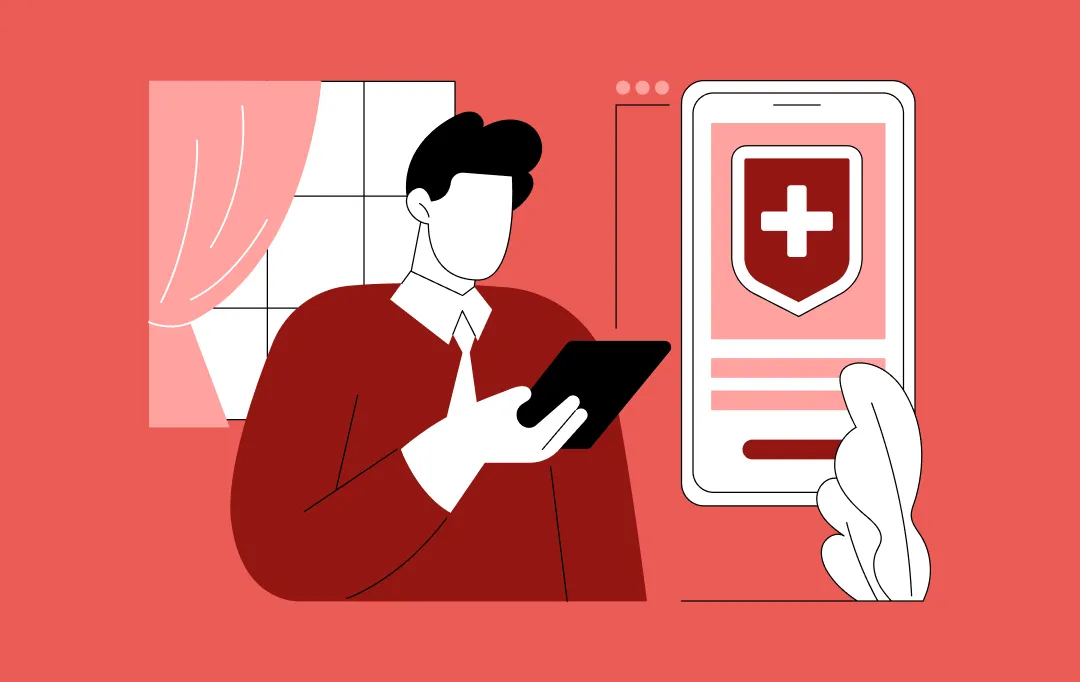
How Much Does Healthcare Software Development Cost in the Middle East? 2026 Cost Guide
Key takeaways: Healthcare software costs in the Middle East range widely because compliance, integrations, and scale matter more than features alone. Enterprise healthcare platforms cost more upfront but reduce long-term risk by replacing fragmented legacy systems. Regulatory alignment and data residency decisions shape architecture and budget from day one. Phased delivery and MVP-led rollouts help…
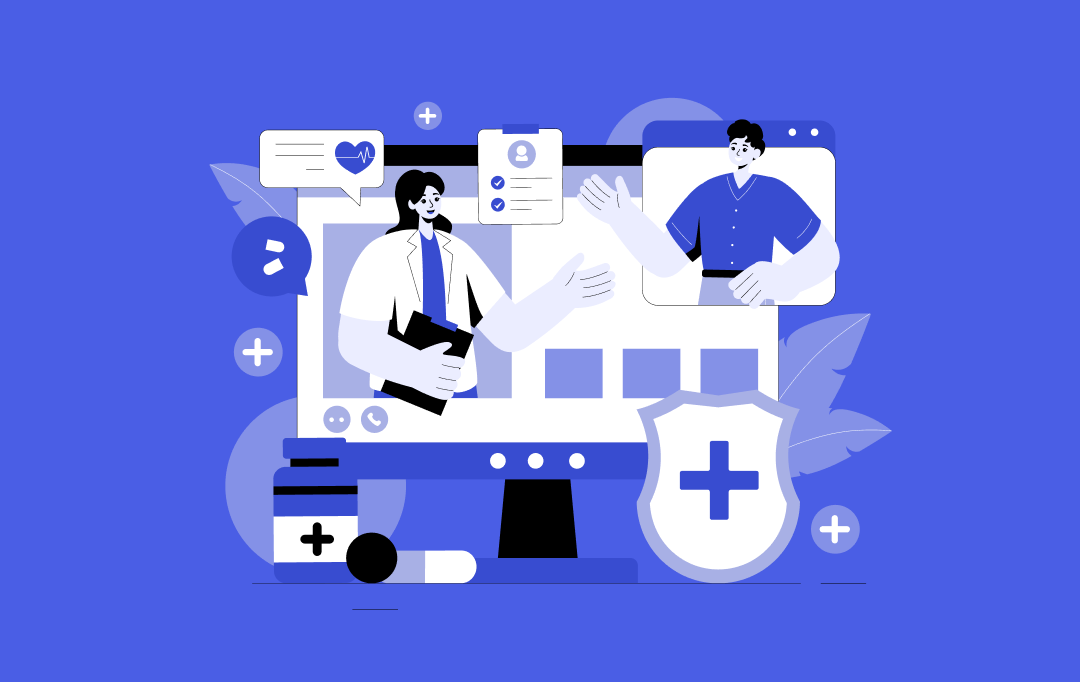
Identity and Access Management in Healthcare: Core Components, Challenges, and Best Practices
Key Takeaways Healthcare runs on trust, and Identity and Access Management is what keeps that trust intact by protecting every login, record, and device. A modern IAM system does more than secure passwords, it connects people, systems, and data safely across hospitals and clinics. AI and automation are changing how IAM works, spotting risks faster…
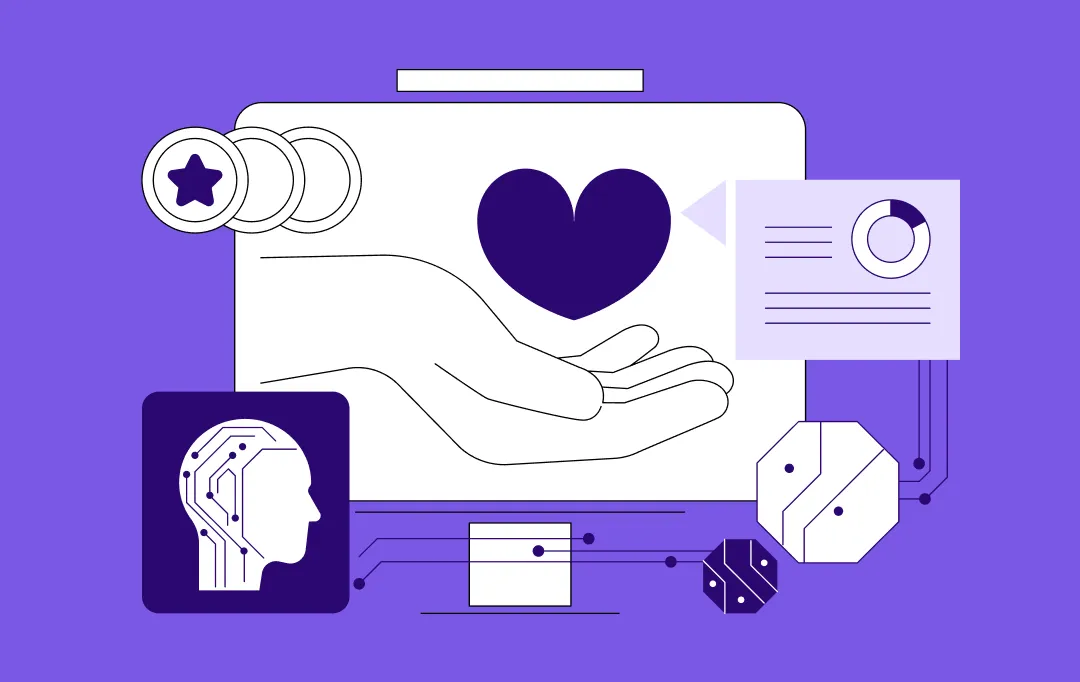
How Telemedicine is Breaking Barriers in Mental Health Care Access and Delivery
Key Takeaways Telemedicine is helping healthcare systems close gaps caused by clinician shortages, long wait times, and limited physical infrastructure. Virtual mental health care boosts access beyond geographical barriers while reducing no-shows, travel barriers, and scheduling conflicts. Hybrid models, remote monitoring, and AI-supported assessments make care more continuous, proactive, and scalable. Partner with Appinventiv to…


